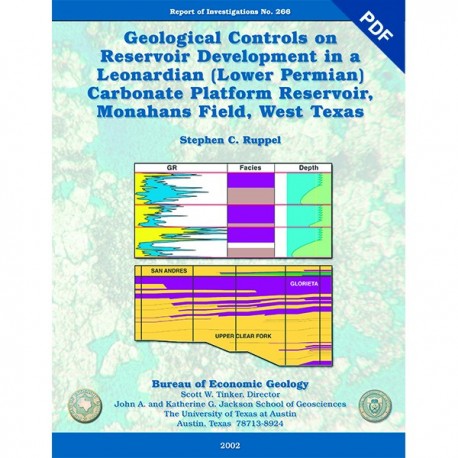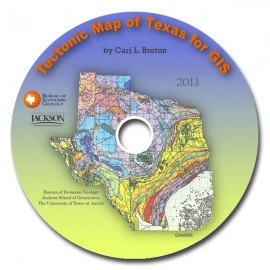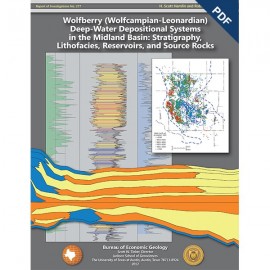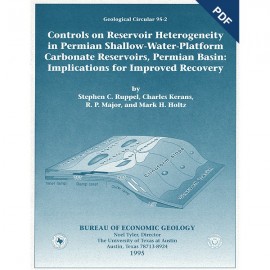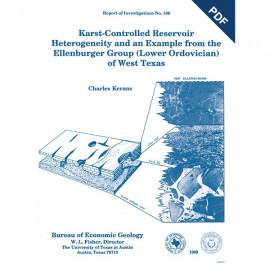Reports of Investigations
-
Books & Reports
- Reports of Investigations
- Guidebooks
- Udden Series
- Geological Circulars
- Down To Earth
- Atlases of Major Oil and Gas Reservoirs
- Texas Memorial Museum Publications
- Environmental Geologic Atlas of the Texas Coastal Zone
- Mineral Resource Circulars
- Other Reports
- Seminars and Workshops
- Handbooks
- Submerged Lands of Texas
- Symposia
- Annual Reports
- Open File Reports
-
Maps & Cross Sections
- Thematic Maps
- Miscellaneous Maps, Charts & Sections
- Geologic Atlas of Texas
- STATEMAP Project Maps
- Geologic Quadrangle Maps
- Cross Sections
- Highway Geology Map
- Energy and Mineral Resource Maps
- Shoreline Change and Other Posters
- Wilcox Group, East Texas, Geological / Hydrological Folios
- Bouguer Gravity Atlas of Texas
- River Basin Regional Studies
- Featured Maps
- Posters
- Teachers & the Public
-
Geological Society Publications
- Gulf Coast Association of Geological Societies
- Alabama Geological Society
- Austin Geological Society
- Corpus Christi Geological Society
- Houston Geological Society
- Lafayette Geological Society
- Mississippi Geological Society
- New Orleans Geological Society
- South Texas Geological Society
- GCS SEPM Publications
- Historic BEG & UT Series
Geological Controls on Reservoir Development in a Leonardian...Carbonate Platform Reservoir...Digital Download
RI0266D
For a print version: RI0266.
RI0266D. Geological Controls on Reservoir Development in a Leonardian (Lower Permian) Carbonate Platform Reservoir, Monahans Field, West Texas, by S. C. Ruppel. 58 p., 39 figs., 2 tables, 2002. doi.org/10.23867/RI0266D. Downloadable PDF.
To purchase this publication in book format, please order RI0266.
About This Publication
This report combines borehole core and geophysical log study with porosity and permeability data to define patterns of facies and permeability distribution in a typical upper Clear Fork reservoir in the Permian Basin. Key findings are that permeability, but not porosity, varies markedly with facies and that spectral gamma ray logs are critical for defining facies, facies architecture, and reservoir quality.
ABSTRACT
Compared with similar reservoirs in younger (Guadalupian) San Andres and Grayburg Formations, reservoirs that developed in the Lower Permian (Leonardian) Clear Fork Group are typified by very low recovery efficiencies. Geological characterization of the Clear Fork reservoir at Monahans field demonstrates that although this situation may result partly from the innate heterogeneity of Clear Fork rocks, it can also result significantly from an overestimation of the mobile oil resource in these fields.
The Clear Fork reservoir at Monahans comprises the upper Clear Fork, Glorieta, and lower San Andres, all of which are characterized by cyclic, multiple-hierarchy, shallow-water, dolomitized carbonates. The cyclicity of these rocks is an important guide to their architecture and correlation. Reservoir development in these rocks reflects the combined influence of depositional and diagenetic controls. Although strong evidence points to selective porosity preservation caused by early diagenesis at cycle tops, petrophysical differences are nevertheless dominantly related to depositional facies. Tidal-flat deposits, for example, display high porosity but widely variable and generally low permeabilities and oil saturations. Subtidal grain-dominated rocks, on the other hand, exhibit similarly high porosity but much more favorable permeabilities and saturations. Distinction between these two facies is thus critical to accurate calculation of permeability and oil saturation and, in turn, to effective recovery of the remaining oil resource in Monahans and similar fields.
Although most wireline logs cannot be used to distinguish critical facies or define cyclicity, spectral gamma-ray logs, when calibrated to cores, provide an accurate picture of the distribution of poor-reservoir-quality, tidal-flat rocks and good-quality, subtidal rocks. At the same time they provide a fundamental basis for defining reservoir architecture by defining cycle boundaries. Both are necessary to develop an accurate picture of reservoir heterogeneity in Clear Fork reservoirs.
Keywords: carbonates, diagenesis, hydrocarbons, Leonardian, Permian, reservoir characterization, stratigraphy
CONTENTS
ABSTRACT
INTRODUCTION
GEOLOGIC SETTING
METHODS
GENERAL STRATIGRAPHY
FACIES AND DEPOSITIONAL ENVIRONMENTS
Tidal-Flat Facies
Mud-Dominated Facies
Grain-Dominated Facies
General Paleoenvironmental Setting
LEONARDIAN SEQUENCE STRATIGRAPHY AND CYCLICITY
Sequence Stratigraphy
Cyclicity
High-Frequency Cycles
Cycle Sets
Wireline-Log Definition Cyclicity
Effects of Cyclicity and Paleotopography on Facies Distribution
RESERVOIR ARCHITECTURE
DIAGENESIS AND POROSITY DEVELOPMENT
Porosity and Mineralogy Trends
Isotope Geochemistry
RESERVOIR PETROPHYSICS
Facies Relationships
Vertical Porosity Trends
Porosity and Permeability Interrelationships
Model for Porosity and Permeability Development
RESERVOIR DEVELOPMENT
Phi*h Trends
Distribution of Original Oil Resources
DISCUSSION
CONCLUSIONS
ACKNOWLEDGMENTS
REFERENCES
Figures
1. Map of West Texas, depicting paleogeography during the Leonardian and locations of major reservoirs developed in Lower Permian (Leonardian) rocks, including Monahans field
2. Diagram showing relative distribution of original oil in place in Permian oil reservoirs in the Permian Basin of
West Texas and New Mexico
3. Diagram depicting hydrocarbon volumetrics of Leonardian carbonate reservoirs in the Permian Basin, West Texas and New Mexico
4. Graph illustrating average current hydrocarbon recovery efficiencies for Leonardian reservoirs as compared with other carbonate reservoirs in the Permian Basin
5. Map of Monahans field area, showing structure at the top of the Glorieta Formation
6. Stratigraphic nomenclature of middle-Permian-age strata in the Permian Basin of West Texas and their relative importance as oil reservoirs
7. Type log for the Monahans Clear Fork reservoir, showing typical facies succession, stratigraphic terminology applied in this study, and position of major stratigraphic markers
8. Typical tidal-flat facies in the Leonardian, Monahans Clear Fork field
9. Typical grain-dominated subtidal facies in the Leonardian, Monahans Clear Fork field
10. Depositional model for middle Permian carbonate platform deposits in the Permian Basin
11. Sequence stratigraphic relationships of Leonardian-age strata in the Permian Basin of West Texas
12. General patterns of facies stacking in the Leonardian in the Permian Basin
13. Ideal cycle in Leonardian rocks on the Central Basin Platform of West Texas
14. Vertical facies succession in the Monahans Clear Fork reservoir succession, showing facies stacking patterns and cyclicity: Well No. 164
15. Vertical facies succession in the Monahans Clear Fork reservoir succession, showing facies stacking patterns and cyclicity: Well No. 270
16. Core photograph of subtidal cycle boundary
17. Typical cycle set in upper Clear Fork at Monahans field, showing facies- and cycle-stacking patterns and gamma-ray log response
18. Stacked cycle sets in the Glorieta
19. Styles of facies stacking and gamma-ray log response in upper Clear Fork cycle set
20. Map depicting the thickness of tidal-flat facies in the lower Glorieta Formation at Monahans field
21. Paleotopographic map of the Clear Fork reservoir interval at Monahans field compared with reservoir structure
22. Comparison of vertical facies successions at the base of the lower upper Clear Fork, which represents long-term transgression in paleotopographically low (Shell Sealy Smith No. 164) and high (Shell Sealy Smith No. 270) cores
23. Comparison of vertical facies successions in the upper, early, highstand. part of the upper Clear Fork in paleotopographically low (Shell Sealy Smith No .164) and high (Shell Sealy Smith No. 270) cores
24. Northwest-southeast cross section A-A’ based on cored well data. showing change in facies in the upper Clear Fork-Glorieta from tidal-flat-dominated (paleotopographically high) to subtidal, grain-dominated (paleotopographically low) facies
25. Northwest-southeast cross section B-B- based on spectral gamma-ray well log correlations
26. Vertical porosity trends in Leonardian cycle sets
27. Downward-decreasing porosity trends. indicated in cycle sets at Monahans field
28. Vertical mineralogical patterns in the Leonardian
29. Scatter plot of carbon and oxygen stable isotope values in cores from the Monahans Clear Fork reservoir
30. Plot of 6180 and 613c with depth. showing cycle-punctuated trends in isotope values
31. Histograms of porosity data from the Monahans Clear Fork reservoir grouped by facies
32. Histograms of permeability data from the Monahans Clear Fork reservoir, grouped by facies
33. Capillary-pressure data from the Monahans Clear Fork reservoir
34. Porosity-permeability relationship for upper Clear Fork subtidal rocks in the Monahans Clear Fork reservoir
35. Porosity-permeability relationship for lower San Andres subtidal rocks in the Monahans Clear Fork reservoir
36. Porosity-permeability relationship for tidal-flat rocks in the Monahans Clear Fork reservoir
37. Geologic model for the development of porosity and permeability in Leonardian rocks
38. Maps of phi*h for the Clear Fork reservoir at Monahans field
39. Cumulative prewaterflood production
Tables
1. Facies petrophysics
2. Calculations of reservoir phi*h
Citation
Ruppel, S. C., 2002, Geological Controls on Reservoir Development in a Leonardian (Lower Permian) Carbonate Platform Reservoir, Monahans Field, West Texas: The University of Texas at Austin, Bureau of Economic Geology, Report of Investigations No. 266, 58 p. doi.org/10.23867/RI0266D.
